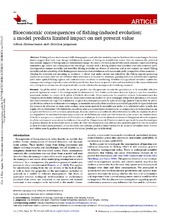Bioeconomic consequences of fishing-induced evolution: a model predicts limited impact on net present value
Peer reviewed, Journal article
Published version
Permanent lenke
http://hdl.handle.net/1956/10181Utgivelsesdato
2015-04Metadata
Vis full innførselSamlinger
Originalversjon
https://doi.org/10.1139/cjfas-2014-0006Sammendrag
Fishing reduces stock size and shifts demographics, and selective mortality may also lead to evolutionary changes. Previous studies suggest that traits may change evolutionarily because of fishing on decadal time scales. Here we examine the potential bioeconomic impacts of fishing-induced evolutionary change. We used a life-history model with stock dynamics based on evolving maturation age, which has consequences for size-at-age, coupled with a fishing module that describes costs and economic yield. Size-dependent natural mortality and trawl-like fishing mortality are drivers of selection, and in the analysis we varied fishing mortality and size-selectivity of the fishing gear to determine trait evolution as well as economic yield. Comparison of two scenarios — allowing for evolution and assuming no evolution — shows that under current size selectivity, the fishing regimes generating maximum economic yield are not different when evolution is accounted for. However, ignoring evolution overestimates long-term yield under optimal fishing regimes and underestimates resilience to overfishing. Whether fishing-induced evolution matters for management strategies depends on size selectivity, stock state, how it acts on specific traits, and its sensitivity to the assumed discount rate, calling for a cautious use of net present value as sole criterion for management of evolving resources.

